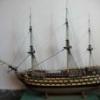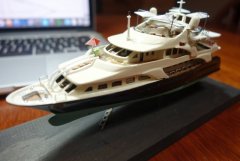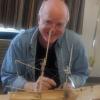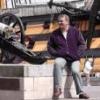Supplies of the Ship Modeler's Handbook are running out. Get your copy NOW before they are gone! Click on photo to order.
×
-
Posts
4,669 -
Joined
-
Last visited
Reputation Activity
-
 augie reacted to Gahm in US Brig Syren by rtropp - Model Shipways - 1:64
augie reacted to Gahm in US Brig Syren by rtropp - Model Shipways - 1:64
Richard, you can find a nice example of that piece with several pictures in Dirk's build log. But you are right, it does not come as a laser cut part in the kit.
Thomas
-
 augie got a reaction from gjdale in Bomb Vessel Granado 1742 by mobbsie - FINISHED - 1/48 - cross-section
augie got a reaction from gjdale in Bomb Vessel Granado 1742 by mobbsie - FINISHED - 1/48 - cross-section
I honestly have no idea how you gentlemen manage to construct such a piece. In a word, fantastic.
-
 augie got a reaction from Omega1234 in Boothbay Harbor One Design 1938 by Jond - FINISHED - 1:6 - RADIO - 21' racing sloop
augie got a reaction from Omega1234 in Boothbay Harbor One Design 1938 by Jond - FINISHED - 1:6 - RADIO - 21' racing sloop
You've chosen a classic, lovely subject. Fair winds !!!
-
 augie reacted to UpstateNY in Red Dragon by UpstateNY - FINISHED - Artesania Latina - Scale 1:60
augie reacted to UpstateNY in Red Dragon by UpstateNY - FINISHED - Artesania Latina - Scale 1:60
Hi All,
From my first attempt at rigging my tiller a few posts back, one problem I had was neatly seizing the blocks. Things just got worse as to help with the scale, I've reduced the my block size to 3mm from 4mm and I am also using much thinner seizing thread as Brian recommended. Now I bought Chuck's Serv-o-matic during his recent sale and thought of a way this past weekend to use it to help me seize my blocks. Perhaps this is old stuff to many, but figured I'd share in case it helps someone.
Pictures tell the story, but I clamped some 3/16in brass tubing to the gears using some 3/16in drill stops. I then glued some connector clips to the 3/16in brass tubing. These fixtures, that are quickly removable, allowed me to hold the small hook and block firmly and use the Serv-o-matic to seize the block. I still need a lot more practice, but you can see in the final picture there is some neater seizing starting to emerge. The looser part you can see was because I removed the block from the machine before the 50/50 glue mix had dried fully and the rope loosened slightly. Fewer turns may help things look neater as well.
Anyway, I think I now have a way to seize these small blocks neatly and also much faster. Acid test will be when I try to use the 2mm blocks I bought to do my cannons!
Hope you found this of some interest...now it's back to my rigging which is proving pretty fun!
Cheers,
Nigel.
-
 augie reacted to SawdustDave in Cutter Cheerful 1806 by SawdustDave - FINISHED - 1:48th scale
augie reacted to SawdustDave in Cutter Cheerful 1806 by SawdustDave - FINISHED - 1:48th scale
Before applying primer and white acrylic, thought I would post this shot of the completed planking of the starboard hull. This is mainly for the purpose of commenting on the technique taught by Chuck P in great detail with the instructions provided with this scratch builders kit.
I have always struggled with single planking. Even after building several fairly challenging models, using my self developed method of planking was always somewhat of a struggle.
I must say, this has to be the best shaped single planked hull I personally have ever built. Chuck's methodical approach to marking the bulkheads and shaping the planks has been a huge learning process for this old dog.
In this photo, after moderate sanding, you can see there will be very little need for fillers before painting.
Now, on to the port side.
-
 augie got a reaction from Jack12477 in USS Constitution by lambsbk – Revell – 1/96 - PLASTIC – With Fiber Optics
augie got a reaction from Jack12477 in USS Constitution by lambsbk – Revell – 1/96 - PLASTIC – With Fiber Optics
Not bad????? I think it looks great. HAPPY BIRTHDAY!!!!
-
 augie got a reaction from Canute in USF Constellation 1797 by Jparsley - Artesania Latina - 1:85 scale
augie got a reaction from Canute in USF Constellation 1797 by Jparsley - Artesania Latina - 1:85 scale
Just catching up. That is really sweet. I'm sure it will become a family heirloom.
-
 augie got a reaction from Canute in Bomb Vessel Granado 1742 by mobbsie - FINISHED - 1/48 - cross-section
augie got a reaction from Canute in Bomb Vessel Granado 1742 by mobbsie - FINISHED - 1/48 - cross-section
I honestly have no idea how you gentlemen manage to construct such a piece. In a word, fantastic.
-
 augie reacted to Jond in Boothbay Harbor One Design 1938 by Jond - FINISHED - 1:6 - RADIO - 21' racing sloop
augie reacted to Jond in Boothbay Harbor One Design 1938 by Jond - FINISHED - 1:6 - RADIO - 21' racing sloop
Building hull # 1 stage 1 get ready to plank
Well here we go again. I thought I could go quickly through these steps as they are similar to other builds in many ways. I want to note where we may find differences because of the unique large scale or other aspects of this boat design. One example will be the unique rudder profile where it " nests" onto the aft edge of the keel. I need not to rush too much though, because at this large scale the crisp lines of the bow stem and transom are key to a successful build.
off to the shop
here I took all the stations and set them up so their legs would have nice square cuts on one sheet of $5 luan. It is nice only having 10 stations this time. I also prefer having the gray shading added to the printout to make them more visible.
Here I am going after scale as well as practicality. The typical fir 1/4 plywood is actually thicker than that. if you laminate three of them you get to 7/8. it's OK for a large fishing schooner, but we are looking to hold 4 inched in scale.
The birch plywood at .19 is better to sandwich the .26 fir ply and give us 5/8 thick keel. Therefore we keep the strength, straightness and stability of 3 play and honor the tighter scale. Also the birch finish is nicer to work with to get sharp edges. I chose to keep the center fir sheet as it will house the attachement for the lead keep which hopefully shall be integral. In this photo I screwed two together using one printout to cut them out just smaller than the center plywood in most areas and bigger for the concealed rudder detail. [ hold for later] here all three are together for fit up.
Now we cut out the stations. We cut close and then dress with a side disc sander.
Here is a lesson learned from my past. Use the CAD to offset a line to cut them out smaller by the planned thickness of the planking, so that after planking we are back to the boats true lines. This step saved much filing.
here is an old friend. We need a building board , so I took the one from the recent big schooner Charlie. wow 21 stations on that one. We shall reuse the blocks and with a little light sanding layout on this old board is fine.
This is the standard method to set the block square and then attach the station leg and work progressively from one end to the other.
Here we have all ten stations set and the bow blocking fit up. I am holding on the transom for this step.
Here we add temporary blocking for all the stations. Simply glue and set in place. they all get knocked out during planking.
Our first glue up.Due to my previous experience I glued the laminated keelsons and the spacers. I did not fill the station slots with glue.
The next day we rip out the clear cedar planking. As before I cut down 1"x 6" stock to 5/32 by 3/4 and then split the 3/4 as in this photo. Doing them myself on the light duty saw they still have some deviation and I need to figure out how to avoid it. One of the club boats is cedar and I will eventually need to plank one exposed, so I must get access to a cabinet maker saw to make them perfect. the other alternate is make them thicker...say 3/16 and then get a gauge sander.
Here is my new stock. I believe for a fiber glassed solid color hull this is just fine. I cut 5/32 so I have a true 1/8" thickneww which allows good sanding for shape before glass.
this step is not complete but is the final step before planking. I have rough carved the bow blocks. Spanning some loose planks I see I have more to do. the sub ribs are 1/32" strips of birch plywood. They are glued to the stations below the floor line where the remaining stations shall become the default floor beams. see the drill holes to facilitate the cut out and removal of the stations[ forms]. I also saw cut that floor line about 3/8" into the station to help with the break out. the blue masking tape is to separate the sub rib from the station when it is knocked out. I will then add fake inner ribs to theses sub ribs and then in between to replicate the design. I need to remove paper from all lower stations and keelson that shall remain before planking. it is much easier now then later. lesson learned is the keelson was not perfectly located as to height in the transom area. I could have sanded and fixed but chose to carefully remove two stations and deepen their cut outs, so the keelson could lower to the right position for the planking to come right over. That is why on the first glue up I did not glue the station slots. Now that all is set, I did glue them. I've definitely got some more work but soon I hope to set some planks and final align the bow blocks and stem and then set up the transom prior to planking.
cheers
-
 augie got a reaction from Jond in Boothbay Harbor One Design 1938 by Jond - FINISHED - 1:6 - RADIO - 21' racing sloop
augie got a reaction from Jond in Boothbay Harbor One Design 1938 by Jond - FINISHED - 1:6 - RADIO - 21' racing sloop
You've chosen a classic, lovely subject. Fair winds !!!
-
 augie reacted to mtaylor in Licorne 1755 by mtaylor - 3/16" scale - French Frigate - from Hahn plans - Version 2.0 - TERMINATED
augie reacted to mtaylor in Licorne 1755 by mtaylor - 3/16" scale - French Frigate - from Hahn plans - Version 2.0 - TERMINATED
Thanks for the "likes" and comments and for helping me push the envelope a bit further.
Sam, no sand blaster here. The alcohol soak gets the smoke and much of the char off. A bit sanding takes care of the rest. It's not so much the char that is the problem but the Euro Boxwood seems to have a lot oil in it that turns into a black glaze when hit by the laser. Not a serious problem though.
Jack, I've got chisels (Dockyard brand) down to 1.5 mm and a couple of micro-surgery scalpels even smaller. The lettering on the plaque is <1mm high.
-
 augie reacted to lambsbk in USS Constitution by lambsbk – Revell – 1/96 - PLASTIC – With Fiber Optics
augie reacted to lambsbk in USS Constitution by lambsbk – Revell – 1/96 - PLASTIC – With Fiber Optics
We have been told to stay off the roads and stay home. Ours was never in any serious flood risk but there are so many around us in lower lying areas that have lost so much. Keep those prayers coming...
-
 augie got a reaction from mtaylor in USF Constellation 1797 by Jparsley - Artesania Latina - 1:85 scale
augie got a reaction from mtaylor in USF Constellation 1797 by Jparsley - Artesania Latina - 1:85 scale
Just catching up. That is really sweet. I'm sure it will become a family heirloom.
-
 augie got a reaction from mtaylor in Boothbay Harbor One Design 1938 by Jond - FINISHED - 1:6 - RADIO - 21' racing sloop
augie got a reaction from mtaylor in Boothbay Harbor One Design 1938 by Jond - FINISHED - 1:6 - RADIO - 21' racing sloop
You've chosen a classic, lovely subject. Fair winds !!!
-
 augie reacted to Jond in Boothbay Harbor One Design 1938 by Jond - FINISHED - 1:6 - RADIO - 21' racing sloop
augie reacted to Jond in Boothbay Harbor One Design 1938 by Jond - FINISHED - 1:6 - RADIO - 21' racing sloop
This build is to be a prototype for potential group of RC boats to race at the Boothbay Harbor Yacht club. First let's discuss why this might be a fun and useful project.
LOA:21'
LWL:18' 9"
Draft:3' 6"
Beam:5' 6"
Sail Area:227.00 sq ft
Displacement:2,100.00 lbs
From Wikipedia
"..Geerd Niels Hendel (14 January 1903 - 30 March 1998) was a naval architect and native of Germany. He found success in the United States becoming a prominent yacht designer who had a hand in an America's Cup victory in 1937.
In 1935, Hendel became chief draftsman for the legendary naval architect Starling Burgess, who at the time was living in Wiscasset, Maine, and working on various projects for the Bath Iron Works, in Bath, Maine
In 1936, Harold Stirling Vanderbilt engaged the Bath Iron Works to build the America’s Cup Defender Ranger, the greatest of all J-class yachts. Geerd Hendel worked with Starling Burgess and a young Olin Stephens on putting together the working drawings (see Olin Stephens’s book, All This and Sailing Too). From his work on Ranger’s aluminum masts, Hendel became one of the early advocates of the use of aluminum in yacht building. That summer, Hendel became a US citizen.
In 1938, Hendel designed the 21-foot fin keel sloop known as the Boothbay Harbor One Design, the culmination of almost a decade’s work of designing, building, and then testing his ideas for fast racing sloops. Geerd Hendel and Starling Burgess actively raced the Hendel Racing Sloop during the years leading up to World War II. ......"
There is more history available through the Boothbay Harbor One Design association, which is hosted on the web site for the Boothbay Harbor Yacht Club.. http://www.bhyc.net/bhoda.html
The short version is the wooden boats were built in the local area through the 1940's and 50's. In the 1970's fiberglass hulls were made. My understanding is they were using cork within the glass element instead of cold forming method . Starting in 2007 two wooden 'original' design were built through the Brooklin boatworks. They took the original design and rebuilt the documents and molds.
The first build boat was named Eight Bells and she is in Boothbay Harbor. the second build included much work at wooden boat school. She is named Osprey and is easy to find on the internet as it is looking for a new home.
Since 2009 a few wooden boats were skinned with two coats of 1/8 cedar veneer and resin. There is a practicum on this process for the boat Bittersweet, No 20, done by the Brooklin boat yard. Finally David Nutt has built a few cold mold form, [4 layers[, at his boat works in Edgecomb Maine. All together there are between 50 to 60 of these boats still sailing and many are still here. There are also several very similar ' sister' boats including the Hodgdon 21 [built by Sonny Hodgdon] also wood hull keel boats, and the Christmas Cove 21 all fiberglass. A similar 21' boat class also the Great lakes 21 lives in Ohio.
I am now the proud owner of Bittersweet No 20. I am hoping to learn more of its History. I am told it was owned for many years by the Reed family. . I found this photo on line and see the extra long fore-deck and after deck, an option in the 1938 design, that matches Bittersweet, so I think this is the same boat.
...Here are before and after images by Brooklin boatworks showing the 1941 built Bittersweet getting her new skin. Note the white transom? Part of my research will be to understand when was that changed from the original Mahogany design.
...Here is the post skinning look at Bittersweet. Still lots to do. The new owner decided to make her a beautiful dark green. He sailed her a bit but she currently is in a barn ready for more work. The plan is by next summer we shall see a new white interior and rigging all ready to resume racing.
Modeling
As to modeling, this project is not a complicated whaling ship, bark or multi-masted fishing schooner, but it is a real classic Maine sailing design. There are many families with long histories of this boat and a thriving youth sailing program all in the same place. Races are Wednesday afternoons and 5-6 weekends through our short summer. They are perfect for fun sailing in this great harbor. My goal is to show up next June with two working radio replicas to race at the club. The first two will be proto types. Ultimately I need to have a choice of either a wood design with wood mast or the fiberglass [ same lines] with an aluminum mast. For now that is shape the spruce and paint "aluminium" but we'll see when we get there. They are also great for a foggy day dockside.
The first step in the build is to get plans. Fortunately the Maine Maritime Museum in Bath has a complete set dated 1938. I am aware that new drawings were created for Eight Bells a few years back and I am looking for them too. I also have Bittersweet and a dozen others to photo and copy. A big challenge for Radio sailing is the fact the jib clews trail aft, past the mast and shroud. Most radio sailors are modified and jibs are redesigned to be a ' self tacking' style so like the Main sail it is only in and out, geared by one pulley to be 50% of the main and can therefore share the same servo. We shall get into that as I have the same issue on the other boats I am working on, Charles Notman a 4 master with a flying and outer jib and the Dancing Feather a Boston Pilot schooner with Jib and flying jib.
I took the plans to Staples to get scanned into PDF's. I then took the image I want ....say station lines .. and saved them as a jpeg. I can then open it in Adobe Photoshop Elements where I can rotate by fractional degrees and using the grid get a plumb image. I then save as a new PDF. I open the new PDF , take snap shot image and paste that into Turbo Cad Deluxe 20.
To build the model, I take the section lines and tweak them to align with the Keelson / side view section lines. I then added the detail framing section and align it below to take on the detail and better understand the build. Similarly I include the framing sections in scale to the lower right.
Now I need to build the ten station sections and transom. I go to the station lines and add layer by layer, tracing the line and then using mirror copy to complete each station mold. I then add common legs to attach to the building board and cut outs for the keelson. I set up a page for each station with its unique named view in the model and viewport on each page.
Finally I offset inward the equivalent of the planking so when I finish the planking, we are back to at the final shape. Here is what gets printed out and glued to the luan plywood.
Keelson assembly planning
Now we have all the stations we need a keelson assembly. This approach takes us away for scale modeling replication to building a model that will sail. To understand please look at the image of the boat framing including the 'floor' sole and keel attachment.
One can see in this framing section there is nothing but bilge under the floor except for the floor timbers. For building a static model there is no problem, but to sail we need to transfer to load from the hull into the keel. It might work but since we can not see below the floor, we shall use that space for structure [ nee the keelson]. We will discuss more as we build out the detail in the open cockpit.
The keelson assembly....
We need floor timbers to support the flooring but also we need to add and extension to the keel.....keelson.. that goes stem to stern. due to scale and size of printer we need to make this in three printouts and then attach.
here is full scale of the aft section of the keelson
we are ready to start the build
-
 augie reacted to Jparsley in USF Constellation 1797 by Jparsley - Artesania Latina - 1:85 scale
augie reacted to Jparsley in USF Constellation 1797 by Jparsley - Artesania Latina - 1:85 scale
It's done it's done yippee it's done now back to my boat I've missed the old girl but sure love my little girl more
-
 augie got a reaction from mtaylor in Bomb Vessel Granado 1742 by mobbsie - FINISHED - 1/48 - cross-section
augie got a reaction from mtaylor in Bomb Vessel Granado 1742 by mobbsie - FINISHED - 1/48 - cross-section
I honestly have no idea how you gentlemen manage to construct such a piece. In a word, fantastic.
-
 augie got a reaction from mobbsie in Bomb Vessel Granado 1742 by mobbsie - FINISHED - 1/48 - cross-section
augie got a reaction from mobbsie in Bomb Vessel Granado 1742 by mobbsie - FINISHED - 1/48 - cross-section
I honestly have no idea how you gentlemen manage to construct such a piece. In a word, fantastic.
-
 augie reacted to Omega1234 in Licorne 1755 by mtaylor - 3/16" scale - French Frigate - from Hahn plans - Version 2.0 - TERMINATED
augie reacted to Omega1234 in Licorne 1755 by mtaylor - 3/16" scale - French Frigate - from Hahn plans - Version 2.0 - TERMINATED
Very nicely done, Mark! I can't carve for the life of me, so I tip my hat off to you!
What you've done is a perfect example of 'if at first you don't succeed, then keep trying and it'll turn out really nicely".
Cheers
Patrick
-
 augie reacted to mtaylor in Licorne 1755 by mtaylor - 3/16" scale - French Frigate - from Hahn plans - Version 2.0 - TERMINATED
augie reacted to mtaylor in Licorne 1755 by mtaylor - 3/16" scale - French Frigate - from Hahn plans - Version 2.0 - TERMINATED
Minor update for the ship... a big one for me.
Planking continues. No pics yet. But while waiting for glue to try, etc. I've been busy working on carvings... or trying to anyway. Also made minor progress on the longboat and a few drawings for parts needing to be cut out.
So.. the carvings. The picture shows the first one I've attempted.. well actually it was the 4th attempt and hopefully, I can live with it. The first two carvings I'll need are the name cartouche on the stern and Arms of France above the stern windows. Mulling it over, I went for the "easy one". I soaked them in isopropyl for about 12 hours and that removed most of the char.
I ended up doing bas-relief style on it after several failures of trying to carve the letters such that they stand proud. Not going to happen in my lifetime. So I ended up removing the char as I carved out about 1/2mm deep leaving the lip and lettering (as one area not the individual letters) standing proud. A touch of well-thinned brown paint (used a needle for this) and what I wanted highlighted is now about as good as it will get. It actually looks better in real-life as most of us don't have eyes with macro mode.
Onwards......
-
 augie reacted to mtaylor in Licorne 1755 by mtaylor - 3/16" scale - French Frigate - from Hahn plans - Version 2.0 - TERMINATED
augie reacted to mtaylor in Licorne 1755 by mtaylor - 3/16" scale - French Frigate - from Hahn plans - Version 2.0 - TERMINATED
Dooohhhhhhh............ Now that the gauntlet has been tossed, I must try it. Yeah... leave the letters and burn the area I want to shave down.... hmm... rats... still leaves clean up around them. That probably won't work either. Good idea though.....
-
 augie reacted to mtaylor in Bomb Vessel Granado 1742 by mobbsie - FINISHED - 1/48 - cross-section
augie reacted to mtaylor in Bomb Vessel Granado 1742 by mobbsie - FINISHED - 1/48 - cross-section
That is an excellent mortar, Mobbsie. I agree with Grant on your underrating of your skills. You even got the crown and shield (?) on it.
-
 augie reacted to mobbsie in Bomb Vessel Granado 1742 by mobbsie - FINISHED - 1/48 - cross-section
augie reacted to mobbsie in Bomb Vessel Granado 1742 by mobbsie - FINISHED - 1/48 - cross-section
Hi Guys,
Thanks for the good word and comments, also those who hit the like button, cheers, very much appreciated.
You'll have to bear with me as I've just down loaded Windows 10 and it's all very strange and I think it's going to take quite some getting used to.
It's update time again.
As seen in my previous post the Sheer Rail was shaped and cut, well it's now fitted and very secure, I followed Grants lead and pinned and used epoxy resin to fix it permanently.
The outer hull planking is now complete and is just waiting for the bolts/treenails, its been a coat of wipe on poly. The one difference is that I've placed a single strake under the wales, the strakes being Yellow Heart and it all stands out quite well.
Now for the Mortar Bed, all made out of Swiss Pear and it seemed more like a jigsaw puzzle than anything else. However, we prevailed and have come up with a piece that I'm quite happy with. All the furniture has been added as has a coat of poly.
The Mortar, now that was a complete different kettle of fish, made from a 1" block of Ebony it really wasn't a job I was looking forward to. With the lathe screw head fitted and the piece fitted into my lathe and the correct selection of carving chisel's of I went. Now I had pictured in my mind just how this was going to turn out but boy was I wrong, I was absolutely disgusted with myself on my first attempt, so it was time to start again. Fortunately I had enough length of wood to continue and not have to reset, the second attempt was much more successful and turned out to be a keeper, I'll let you make your own minds up about that.
The Mortar and the Bed have now been married up and all clamps made and fitted, all in all I'm quite pleased with this part of the build, it's like a separate model on it's own.
OK, now for the tricky bit, the pictures, I'll most likely lose everything now.
It's not gone quite to plan but I hope you like the pics and as always all comments and remarks are most welcome
mobbsie
-
 augie reacted to _SalD_ in US Brig Syren by _SalD_ – FINISHED - 3/16" scale
augie reacted to _SalD_ in US Brig Syren by _SalD_ – FINISHED - 3/16" scale
Chapter 12 – Deck Fittings
I was going to start this chapter by cutting and assembling the coaming frame pieces for the small aft-most hatch until I read Chuck’s Cheerful build log and how he made his hatches. In his log he, and it seems so obvious now, recommended building the grating first and then build the frame to fit around it. So following Obi-Wan-Passaro’s advice I changed course and made all the grating pieces for the hatches. This worked out well because I was able to lay out the grating so I ended up with a banded edge all around the perimeter of the grating. The pieces are slightly smaller or larger than what’s shown on the drawing but not enough to be noticeable. After inserting all the bars to make the proper size grating I squared it up using a few Lego blocks. The piece was made upside down and held together using a tiny drop of ca glue at each joint.
After letting the pieces set overnight I cut the excess off using a hobby miter box. You need to cut very slowly as some of the pieces may loosen up. After cutting the edges were sanded smooth and any loose bars were re-glued.
Now I can make the frames. (errrrr…right Chuck?)
-
 augie got a reaction from CaptainSteve in Cutter Cheerful 1806 by SawdustDave - FINISHED - 1:48th scale
augie got a reaction from CaptainSteve in Cutter Cheerful 1806 by SawdustDave - FINISHED - 1:48th scale
Sorry to hear about the infection Dave. But what a great idea to show your appreciation of the doctor's work.
Think I'll pull up a chair. Chuck's design and your workmanship should be a dynamite combo!










